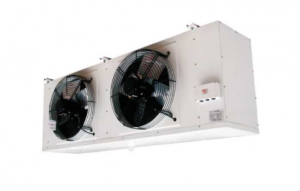The cold storage evaporator is a type of evaporator used in cold storage (the industry term is “air cooler”). Its function is to allow low-temperature, low-pressure saturated refrigerant, acting as a thermal expansion valve, to exchange heat with the medium being cooled, vaporizing the saturated refrigerant and removing heat from the cold storage. A cold storage evaporator mainly consists of five key components: cooling heat exchange pipes, an axial fan, a distributor, a defrosting device, and a drip tray. High-pressure, room-temperature liquid refrigerant from the cold storage condenser is throttled by the thermal expansion valve and directly enters the distributor of the evaporator for uniform distribution before being sent to the heat exchange pipes for vaporization and heat absorption. The axial fan of the evaporator forces air to circulate within the cold storage, achieving the purpose of cooling.

The cooling principle of an evaporative air cooler is as follows: When the fan is running, it creates negative pressure inside the cavity, forcing outside air to flow through the porous, moistened surface of the evaporative cooling pad. This forces the dry-bulb temperature of the air passing through the pad to drop to near the wet-bulb temperature of the outside air. Specifically, the dry-bulb temperature at the cooler’s outlet is 5-12°C lower than the outdoor dry-bulb temperature (up to 15°C in hot, dry regions). The drier and hotter the air, the greater the temperature difference, and the better the cooling effect. Because the air is always drawn from outside into the room (this is called a positive pressure system), it maintains fresh indoor air. Simultaneously, due to its evaporative cooling principle, it has dual functions of cooling and humidifying (relative humidity can reach approximately 75%). In textile and knitting workshops, it not only improves cooling and humidification conditions but also purifies the air, reduces yarn breakage during the knitting process, and improves the quality of textile products. Evaporative air coolers (also known as wet curtain air conditioners) are surrounded by honeycomb-shaped wet curtains made of special materials, providing a large surface area. A water circulation system continuously humidifies these curtains. Inside, a high-efficiency, low-noise, energy-saving fan creates negative pressure, forcing outside air through the porous, moistened curtains into the unit. The evaporation of water on the curtains absorbs heat, cooling the air passing through. Simultaneously, the evaporation of water from the curtains increases the humidity of the air, thus providing the dual function of cooling and humidifying.

Folding Industrial Evaporative Air Coolers
Dry-type evaporative air coolers are commonly used in industry. They rely on air passing through evaporator coils inside the cooler to cool the forced-flowing air outside the coils. When installed on the floor in a cold storage room, it’s called a floor-standing evaporative air cooler; when installed on the ceiling, it’s called a roof-mounted evaporative air cooler.
Because the surface temperature of the evaporator in a cold storage unit is below 0℃, frost will form on the outer surface of the cold storage air cooler as the refrigeration time increases. This frost not only severely affects the heat transfer coefficient of the cold storage air cooler but also significantly reduces the circulating air volume. This severely impacts the heat exchange capacity of the cold storage air cooler, leading to a significant decrease in the operating performance of the cold storage equipment. To ensure good heat exchange performance, defrosting is essential for the cold storage air cooler. Currently, the most common defrosting method for cold storage air coolers is electric defrosting. Electric defrosting has many advantages, such as thorough defrosting and automatic control, making it popular in many small cold storage, pharmaceutical, and vegetable cold storage projects.
Air cooler structural types include floor-standing , floor-standing top-blowing , floor-standing bottom-blowing , floor-standing horizontal-blowing , ceiling-mounted , and modular types.
Post time: Nov-17-2025




